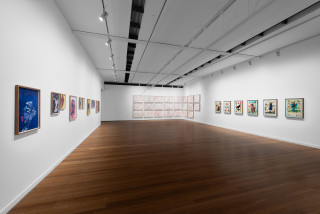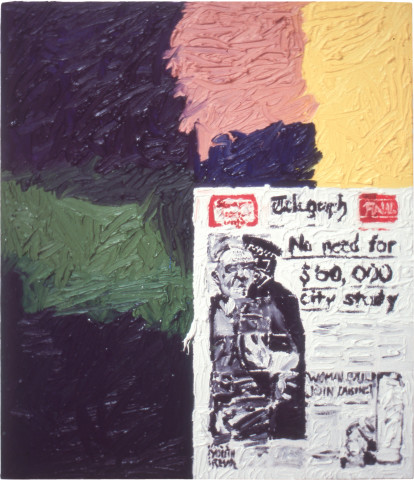
In this exhibition of work by five young women painters, there is no uniform style, no predetermined visual language. But there is something which both separates and identifies these artists - what one could call a personalised distancing where the artist deeply invests the work with idiosyncratic obsessions while pictorially keeping the viewer at a distance.
Featuring works by: Maria Kozic, Vivienne Shark LeWitt, Jan Murray, Susan Rankine and Jenny Watson. 1982.
Exhibition Dates: 13 May – 5 June 1982
Anyone who has watched art over the past three or four years will have noticed a shift among young artists who make no concessions to the uniform abstraction of their predecessors. In this exhibition of work by five young women painters, there is no uniform style, no predetermined visual language. But there is something which both separates and identifies these artists - what one could call a personalised distancing where the artist deeply invests the work with idiosyncratic obsessions while pictorially keeping the viewer at a distance. The work here is linked only by that which assures its individual autonomy: a personal iconology which is embodied in the figurative. Susan Rankine's futuristic architectural settings with their menacing deep spaces are utterly alien to the benign and suburban dwellings of Jenny Watson's childhood. Each artist has appropriated her immediate environment as a personalised subject matter, but the viewer is refused further entry into the artist's life. It is as though these pictures are cordoned off from the viewer's questions and curiosity. The artist's domain is kept either enigmatic or is presented as an ironical and self-conscious return to the immediate past.
In Vanity is in the Eye of the Beholder Vivienne Shark Le Witt turns the curious eve back on itself, where the mirror acts as metaphor for both "the artist's search for identity (the perceiving and reflecting of self through picture making), as well as the allusion to the fact that this small painting is the mirror of the work of Balthus, an artist to whom LeWitt frequently quotes or alludes. LeWitt's own writing, based on her wide reading of semiotics and post-structuralist theory, clarifies her intent. She states that the mod look (suits. ties, the look of the '60s) is ideologically detached from references and influences. and is then appropriated into a new rhetoric and sign system so that its presuppositions are both registered and discounted. Any analysis of her work must proceed from a similar starting point. Except for one, the figurative compositions here are all framed by a white surround, so that the implication is suddenly clear: "You are looking at a painting of a painting." Only Gargoyle has no border, significantly so, since the beast warns the viewer away and protects its (and the artist's) territorial right to privacy. Half human, half animal. the gargoyle is both personal (human) and distanced (protective beast), and possesses its own space.
In their recent work both Jenny Watson and Maria Kozic have quarried Pop art and its deadpan commentary on culture. But a cultural critique is here jettisoned for the most extreme form of distancing. Twiggy may have once been an idol for young teenagers aspiring to the fashionable mod look. Anyone who lived through the '60s might identify her as an archetypal image of woman as a fetishised object of the media. But Watson's possession of Twiggy as a cultural sign is far removed from the original context of the '60s. Twiggy is submitted to a flow of art historical associations the proto-Pop and still painterly stroke of Johns, the flatness of Greenburg's prescription for all abstract painting, the High Pop image as icon of Warhol's cool deification of Marilyn Monroe or Elvis Presley. Yet Watson achieves this alliance of sources with a coolness beyond its original intent. The detachment in this work is only equalled by the artist's personal fascination with the '60s as a potential library of styles.
Figuration then, is the carrier of content which lurks within these pictures. But the precise meaning of the signs and symbols employed remains veiled. Jan Murray's titles give only a hint of the complexity of meaning evoked, but the allusion to flight, pleasure and Freud conjures up an immediate reading of escape. approach-avoidance, and the free flowing subconscious power of the libido. The viewer hovers on the boundaries of interpretation. suspecting in the titles and the theatricality of the image, the personal reference to daily life. The immediate environment of studio and living quarters are sensed. but never made explicit. The search for identity is appropriately concealed behind metaphoric curtains which are pulled between artist and viewer. So much of private life is exposed and no more.
Elsewhere the return of figuration has been assigned a bewildering variety of titles. It crops up as New lmagism (a particularly American strain), Naive Nouveau, New Wave (Australia) and even International National which says something about the belief that an international style still lingers. but has been ruptured by the invasions of a style based on the personal and regional. Whatever its nomenclature, the shift from abstraction and its discontents is underlined by a particular matrix of characteristics: the cultural irony of signs, quoting the immediate art historical past, reinvesting emblematic and iconic imagery with a personal iconology and withholding the self by detachment. displacement and distance.
There is one other observation which sets this work off from its surrounds. Much has been made of women's work as diaristic and autobiographical, as a means of searching for models in mothers. aunts and other women. This work too, as ultimately with all artistic expression, is a search for identity, but in a manner which questions the direct revelation of self, which submits the means of expressing the identity to a stringent examination often informed by psychoanalysis, structuralist theory, the language of architecture and an awareness of the work of art which can only be partially read.
— Memory Holloway, Monash University
 Group Show, Works on Paper
Group Show, Works on Paper
Roslyn Oxley9 Gallery, 2024-25
 Group Show, The First 40 Years
Group Show, The First 40 Years
Roslyn Oxley9 Gallery, 2024
 Group Show, The Winter Bride
Group Show, The Winter Bride
Roslyn Oxley9 Gallery, 2023
 Group Show, A Painting Show
Group Show, A Painting Show
Roslyn Oxley9 Gallery, 2020-21
 Group Show, The Like Button
Group Show, The Like Button
Roslyn Oxley9 Gallery, 2018-19
 Group Show, State of Play
Group Show, State of Play
Roslyn Oxley9 Gallery, 2017
 Group Show
Group Show
Roslyn Oxley9 Gallery, 2016
 Group Show
Group Show
Roslyn Oxley9 Gallery, 2015
 Group Show, Never-Never Land (A Collaboration with Utopian Slumps)
Group Show, Never-Never Land (A Collaboration with Utopian Slumps)
Roslyn Oxley9 Gallery, 2014
 Group Show, Dawson, Griggs, Moore
Group Show, Dawson, Griggs, Moore
Roslyn Oxley9 Gallery, 2013
 Group Show, Cronies
Group Show, Cronies
Roslyn Oxley9 Gallery, 2012
 Group Show, Groups Who
Group Show, Groups Who
Roslyn Oxley9 Gallery, 2011-12
 Group Show, Head On Photography Festival
Group Show, Head On Photography Festival
Roslyn Oxley9 Gallery, 2011
 Group Show, True Story
Group Show, True Story
Roslyn Oxley9 Gallery, 2010-11
 Group Show, Everything's Alright
Group Show, Everything's Alright
Roslyn Oxley9 Gallery, 2010
 Group Show
Group Show
Roslyn Oxley9 Gallery, 2009-10
 Group Show, Lucky Town
Group Show, Lucky Town
Roslyn Oxley9 Gallery, 2008-09
 Group Show, OBLIVION PAVILION
Group Show, OBLIVION PAVILION
Roslyn Oxley9 Gallery, 2008
 Group Show, Summer '07 '08
Group Show, Summer '07 '08
Roslyn Oxley9 Gallery, 2007
 Group Show, STOLEN RITUAL
Group Show, STOLEN RITUAL
Roslyn Oxley9 Gallery, 2006-07
 Group Show, Rectangular Ghost
Group Show, Rectangular Ghost
Roslyn Oxley9 Gallery, 2006
 Group Show
Group Show
Roslyn Oxley9 Gallery, 2005
 Group Show, If these walls could talk
Group Show, If these walls could talk
Roslyn Oxley9 Gallery, 2005
 Group Show, Z
Group Show, Z
Roslyn Oxley9 Gallery, 2003
 Group Show, Dirty Dozen
Group Show, Dirty Dozen
Roslyn Oxley9 Gallery, 2002
 Group Show, The First 20 Years
Group Show, The First 20 Years
Roslyn Oxley9 Gallery, 2002
 Group Show, All Stars
Group Show, All Stars
Roslyn Oxley9 Gallery, 2000
 Group Show, more apt to be lost than got
Group Show, more apt to be lost than got
Roslyn Oxley9 Gallery, 2000
 Group Show, Gang of Four
Group Show, Gang of Four
Roslyn Oxley9 Gallery, 1999
 Group Show, Every other day
Group Show, Every other day
Roslyn Oxley9 Gallery, 1998
 Group Show
Group Show
Roslyn Oxley9 Gallery, 1997
 Group Show, A constructed world (in collaboration with John Wolseley)
Group Show, A constructed world (in collaboration with John Wolseley)
Roslyn Oxley9 Gallery, 1997
 Group Show, Young British Artists
Group Show, Young British Artists
Roslyn Oxley9 Gallery, 1996
 Group Show, Stockroom
Group Show, Stockroom
Roslyn Oxley9 Gallery, 1995
 Group Show, Blow Up
Group Show, Blow Up
Roslyn Oxley9 Gallery, 1995
 Group Show, Photosynthesis
Group Show, Photosynthesis
Roslyn Oxley9 Gallery, 1994
 Group Show, Queerography
Group Show, Queerography
Roslyn Oxley9 Gallery, 1994
 Group Show, 115 58' EAST 31 56' SOUTH
Group Show, 115 58' EAST 31 56' SOUTH
Roslyn Oxley9 Gallery, 1993
 Group Show, High pop
Group Show, High pop
Roslyn Oxley9 Gallery, 1993
 Group Show
Group Show
Roslyn Oxley9 Gallery, 1992
Group Show, T.I.S.E.A.
Roslyn Oxley9 Gallery, 1992
Group Show, Abstract Art
Roslyn Oxley9 Gallery, 1992
 Group Show, Christmas show
Group Show, Christmas show
Roslyn Oxley9 Gallery, 1991
 Group Show, Ramingining Bark Paintings and Sculpture
Group Show, Ramingining Bark Paintings and Sculpture
Roslyn Oxley9 Gallery, 1991
 Group Show, Ramingining
Group Show, Ramingining
Roslyn Oxley9 Gallery, 1991
 Group Show
Group Show
Roslyn Oxley9 Gallery, 1990
 Group Show, Strange harmony of contrasts
Group Show, Strange harmony of contrasts
Roslyn Oxley9 Gallery, 1990
 Group Show, Recent Works from Ramingining and Maningrida
Group Show, Recent Works from Ramingining and Maningrida
Roslyn Oxley9 Gallery, 1989
 Group Show, The Cocktail Party (All Gallery Artists)
Group Show, The Cocktail Party (All Gallery Artists)
Roslyn Oxley9 Gallery, 1988
 Group Show, 7th Biennale of Sydney
Group Show, 7th Biennale of Sydney
Roslyn Oxley9 Gallery, 1988
Group Show, Mardi Gras exhibition
Roslyn Oxley9 Gallery, 1988
 Group Show, 1968-1988 Selected works
Group Show, 1968-1988 Selected works
Roslyn Oxley9 Gallery, 1988
Group Show, Video Festival
Roslyn Oxley9 Gallery, 1987
 Group Show, Chaos
Group Show, Chaos
Roslyn Oxley9 Gallery, 1987
 Group Show, A Resistant Spirit
Group Show, A Resistant Spirit
Roslyn Oxley9 Gallery, 1986
 Group Show, The Forbidden Object
Group Show, The Forbidden Object
Roslyn Oxley9 Gallery, 1986
Group Show, Yuletide nuptials fashion show
Roslyn Oxley9 Gallery, 1985
Group Show
Roslyn Oxley9 Gallery, 1984
 Group Show, Dreams and Nightmares
Group Show, Dreams and Nightmares
Roslyn Oxley9 Gallery, 1984
Group Show, Young artists
Roslyn Oxley9 Gallery, 1983














